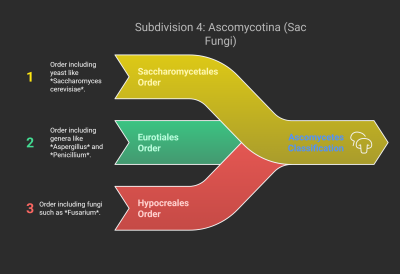+ View more
Course overview
What will i learn?
- Student can compile the general characteristics of fungi and distinguish the different characteristic of fungi
Requirements
- Fungi is derived from the Latin word fungour Fungi are a diverse group of eukaryotic organisms- yeasts, molds, and mushrooms. According to Bessey (1968), fungi are chlorophyll less non vascular plants whose reproductive or vegetative structure do not permit them to be assigned to position among recognized group of higher plants. The branch of botany that deals with the fungi is called mycology and the scientist who is concern with the fungi is called a mycologist. P. A. Micheli known as father of mycology whereas E. J. Butler refer to as father of Indian mycology.
Curriculum for this course
0 Lessons
00:00:00 Hours
Frequently asked question
1.What do you understand by fungi?
Fungi are saprophytic and parasitic spore-producing eukaryotic typically filamentous organisms formerly classified as plants that lack chlorophyll and include molds, rusts, mildews, smuts, mushrooms, and yeasts
Q2.3.Give the classification of fungi as proposed by Ainsworth
The system divides Kingdom Mycota into two main divisions
Myxomycota (Slime molds):
Features non-cellular plasmodial or pseudoplasmodial structures
Contains four classes:Acrasiomycetes (cellular slime molds)Hydromyxomycetes (net slime molds)Myxomycetes (true slime molds)Plasmodiophoromycetes (parasitic slime molds)
Eumycota (True fungi):
Divided into five subdivisions
Subdivision 1: Mastigomycotina (Zoosporic Fungi)
Possess motile spores (zoospores) with flagella
Found in aquatic environments
Class 1: Chytridiomycetes (e.g., Synchytrium)
Class 2: Oomycetes (e.g., Phytophthora infestans - late blight
Subdivision 2: Zygomycotina (Zygospore-forming Fungi)
Coenocytic hyphae (aseptate)
Sexual reproduction through zygospores
Class: Zygomycetes
Order: Mucorales (e.g., Rhizopus stolonifer - black bread mold)
Order: Entomophthorales (e.g., Entomophthora)
Subdivision 3: Ascomycotina (Sac Fungi)
Produce ascospores inside an ascus
Largest fungal group
Class: Ascomycetes
Order: Saccharomycetales (e.g., Saccharomyces cerevisiae - yeast)
Order: Eurotiales (e.g., Aspergillus, Penicillium)
Order: Hypocreales (e.g., Fusarium)
Subdivision 4: Basidiomycotina (Club Fungi)
Spores (basidiospores) produced on a basidium
Include mushrooms and rust fungi
Class: Basidiomycetes
Subdivision 5: Deuteromycotina (Fungi Imperfecti)
No known sexual stage
Includes many pathogenic fungi
Class: Deuteromycetes
Order: Moniliales (e.g., Alternaria, Fusarium)
Order: Sphaeropsidales (e.g., Phoma)
Order: Agaricales (e.g., Agaricus bisporus - edible mushroom)
Order: Uredinales (e.g., Puccinia graminis - wheat rust)
Order: Ustilaginales (e.g., Ustilago - smut fungi)
+ View more
Other related courses
Updated Thu, 24-Apr-2025
0
$0
Updated Thu, 24-Apr-2025
0
Free
About instructor
Student feedback


Write a public review